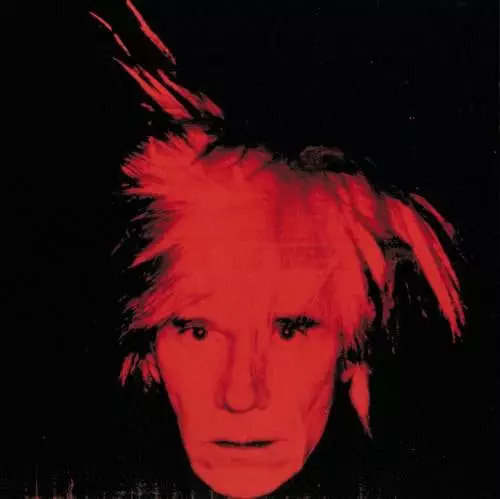
In an age obsessed with celebrity, from A to Z-list, Andy Warhol’s prophetic statement – “In the future, everyone will be world-famous for 15 minutes” – is frequently quoted and misquoted. His brash screen prints reproduced the mass-culture of America, reducing it to archly witty archetypes of cows, guns and Campbell’s Soup. However, he’s best known for his portraits – Liz, Marilyn, Elvis and Queenie herself – similarly multiplied in garish colours, forming a production line of fame. You can’t see any of these ubiquitous images in the Graves’ Warhol show, more interestingly it explores his late self-portraits where Andy’s pitiless gaze is directed at himself. These images feel closer to the artist than Warhol’s cheery pop art, not only because they carry his image but unlike the commercially processed screen prints, many of these works were hand-painted and lived with Andy in his studio throughout his final years.
The word ‘late’ isn’t just a chronological descriptor, death feels very near in these works, many of which were made in the period after Warhol survived a third gun attack which left him broken and fragile. In one picture his eyes are black and sunken, in another his skin looks paper-thin, elsewhere his face cadaverous. Presiding over it all is a huge red-tinged print of Andy in one of his many ‘fright wigs’. It’s a stunning sight, half Bowie’s Aladdinsane, half Catholic icon. At the other end of the scale the exhibition features a case of rarely-seen polaroids, perhaps the perfect medium for Andy’s curiously enduring throw-away art. These were Warhol’s version of sketches and you can see the shapes, lines and shadows being translated into the larger-scale works on the walls. In one run of photos Andy frowns from behind thick pancake make-up and glossy golden wigs, dragged up to nines. Opposite, a series of skulls strip the self-portrait right back to the bone. When the wig, the make-up and the flesh has been taken off all that’s left is a series of momento moris in colourways of more sombre shades than Andy’s usual acid brights.
Curator Alison Morton showed me round the exhibition and explained why we’re lucky enough to have it in Sheffield. Andy Warhol: Late Self Portraits is part of Artist Rooms, a scheme administered by the Art Fund which brings an extraordinary collection donated by art mogul Anthony d’Offay to galleries all over the country. This exhibition is particularly close to d’Offay’s heart, not only was Warhol a personal friend but he commissioned many of the portraits featured in the show. d’Offay has a Sheffield connection too having been born in the city, which is perhaps why he’s leant additional works to the Graves from his personal collection, not included in his gift to the nation.
The exhibition is intimate in scale and tone and perfectly augmented by a second room containing a round table laid with cassette players of various ages. Here you can listen to Warhol’s family and friends talking about the Andy they knew. These twelve voices are a small selection of interviews undertaken by the academic Jean Wainwright from Andy’s youngest brother to recent artists he influenced like Gavin Turk. Each of them describe a different Andy and despite his repeated image in one room and his often spoken name in another there remains a tantalising blank at the centre of the Warhol myth. Alison Morton points out that the only thing the interviews seem to agree on is that Andy was shy. Surely shyness is a mere affectation of a man who surrounded himself with celebrities and made multiple prints of his own face… and yet there’s something elusive about his gaze and evasive about his disguises which keeps the real Andy Warhol at bay even in this room filled with his iconic image.
Andy Warhol: Late Self Portraits runs until 1 December 2012 at Museums Sheffield: Graves Gallery.